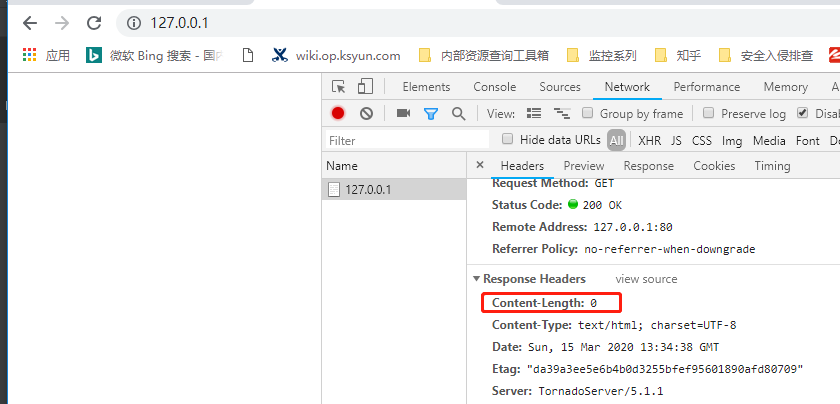7.2 Tornado异步
因为epoll主要是用来解决网络IO的并发问题,所以Tornado的异步编程也主要体现在网络IO的异步上,即异步Web请求。
1. tornado.httpclient.AsyncHTTPClient
Tornado提供了一个异步Web请求客户端tornado.httpclient.AsyncHTTPClient用来进行异步Web请求。
fetch(request, callback=None)
用于执行一个web请求request,并异步返回一个tornado.httpclient.HTTPResponse响应。
request可以是一个url,也可以是一个tornado.httpclient.HTTPRequest对象。如果是url,fetch会自己构造一个HTTPRequest对象。
HTTPRequest
HTTP请求类,HTTPRequest的构造函数可以接收众多构造参数,最常用的如下:
- url (string) – 要访问的url,此参数必传,除此之外均为可选参数
- method (string) – HTTP访问方式,如“GET”或“POST”,默认为GET方式
- headers (HTTPHeaders or dict) – 附加的HTTP协议头
- body – HTTP请求的请求体
HTTPResponse
HTTP响应类,其常用属性如下:
-
- code: HTTP状态码,如 200 或 404
- reason: 状态码描述信息
- body: 响应体字符串
- error: 异常(可有可无)
2. 测试接口
新浪IP地址库
接口说明
1.请求接口(GET):
http://int.dpool.sina.com.cn/iplookup/iplookup.php?format=json&ip=[ip地址字串]
2.响应信息:
(json格式的)国家 、省(自治区或直辖市)、市(县)、运营商
3.返回数据格式:
{"ret":1,"start":-1,"end":-1,"country":"\u4e2d\u56fd","province":"\u5317\u4eac","city":"\u5317\u4eac","district":"","isp":"","type":"","desc":""} 3. 回调异步
#!/usr/bin/env python3 # -*- coding:utf-8 -*- # @Time: 2020/3/15 19:38 # @Author:zhangmingda # @File: asyncHTTPClient_on_server.py # @Software: PyCharm # Description: 学习异步客户端httpclient.AsyncHTTPClient from tornado.options import options from tornado.options import parse_command_line from tornado.web import RequestHandler, asynchronous,Application from tornado.httpserver import HTTPServer from tornado.ioloop import IOLoop from tornado.httpclient import AsyncHTTPClient import tornado import base64,uuid,os,json class AsyncHttpclientIndexHandler(RequestHandler): '''学习异步请求客户端''' #不关闭连接,也不发送响应 @asynchronous def get(self, *args, **kwargs): http = AsyncHTTPClient() req_url = "http://myip.ksyun.com" print('发起请求:',req_url) http.fetch(request=req_url, callback=self.on_response ) def on_response(self,response): if response.error: print('send_error:500') self.send_error(500) else: self.xsrf_token data = response.body print('获取返回值response.body : ',data) self.write(data.decode('utf-8')) # 发送响应信息,结束请求处理 self.finish() if __name__ == '__main__': parse_command_line() options.define(name='port',default=80,type=int,help="服务监听端口") url = [ (r'/',AsyncHttpclientIndexHandler) ] BASEDIR = os.path.dirname(__file__) static_path = os.path.join(BASEDIR,'statics') template_path = os.path.join(BASEDIR,'templates') app = Application(url, static_path=static_path, template_path=template_path, cookie_secret=base64.b64encode(uuid.uuid4().bytes + uuid.uuid4().bytes), xsrf_cookies=True, debug=True ) http_server = HTTPServer(app) http_server.listen(options.port) IOLoop.current().start()

@tornado.web.asynchronous
此装饰器用于回调形式的异步方法,并且应该仅用于HTTP的方法上(如get、post等)。
此装饰器不会让被装饰的方法变为异步,而只是告诉框架被装饰的方法是异步的,当方法返回时响应尚未完成。只有在request handler调用了finish方法后,才会结束本次请求处理,发送响应。
不带此装饰器的请求在get、post等方法返回时自动完成结束请求处理(只返回状态码,来不及返回任何数据)。
4. 协程异步
在上一节中我们自己封装的装饰器get_coroutine在Tornado中对应的是@tornado.gen.coroutine 装饰器。
class GenAsyncIndexHandler(RequestHandler): '''使用yield类似协程的方式''' @coroutine def get(self, *args, **kwargs): req_url = "http://myip.ksyun.com" http = AsyncHTTPClient() response = yield http.fetch(req_url) if response.error: self.send_error(500) else: self.write(response.body)
也可以将异步Web请求单独出来:
class Gen2AsyncIndexHandler(RequestHandler):
'''使用yield类似协程的方式'''
@coroutine
def get(self, *args, **kwargs):
req_url = "http://myip.ksyun.com"
rep = yield self.get_client_ip(req_url)
print(type(rep))
if rep != 'error':
self.write(rep)
else:
self.send_error(500)
@coroutine
def get_client_ip(self,url):
http = AsyncHTTPClient()
response = yield http.fetch(url)
if response.error:
rep = 'error'
else:
rep = response.body
raise tornado.gen.Return(rep) # 此处需要注意
代码中我们需要注意的地方是get_ip_info返回值的方式,在python 2中,使用了yield的生成器可以使用不返回任何值的return,但不能return value,
因此Tornado为我们封装了用于在生成器中返回值的特殊异常tornado.gen.Return,并用raise来返回此返回值。
并行协程
Tornado可以同时执行多个异步,并发的异步可以使用列表或字典,如下:
class IndexHandler(tornado.web.RequestHandler):
@tornado.gen.coroutine def get(self): ips = ["14.130.112.24", "15.130.112.24", "16.130.112.24", "17.130.112.24"] rep1, rep2 = yield [self.get_ip_info(ips[0]), self.get_ip_info(ips[1])] rep34_dict = yield dict(rep3=self.get_ip_info(ips[2]), rep4=self.get_ip_info(ips[3])) self.write_response(ips[0], rep1) self.write_response(ips[1], rep2) self.write_response(ips[2], rep34_dict['rep3']) self.write_response(ips[3], rep34_dict['rep4']) def write_response(self, ip, response): self.write(ip) self.write(":<br/>") if 1 == response["ret"]: self.write(u"国家:%s 省份: %s 城市: %s<br/>" % (response["country"], response["province"], response["city"])) else: self.write("查询IP信息错误<br/>") @tornado.gen.coroutine def get_ip_info(self, ip): http = tornado.httpclient.AsyncHTTPClient() response = yield http.fetch("http://int.dpool.sina.com.cn/iplookup/iplookup.php?format=json&ip=" + ip) if response.error: rep = {"ret:1"} else: rep = json.loads(response.body) raise tornado.gen.Return(rep) 5. 关于数据库的异步说明
网站基本都会有数据库操作,而Tornado是单线程的,这意味着如果数据库查询返回过慢,整个服务器响应会被堵塞。
数据库查询,实质上也是远程的网络调用;理想情况下,是将这些操作也封装成为异步的;但Tornado对此并没有提供任何支持。
这是Tornado的设计,而不是缺陷。
一个系统,要满足高流量;是必须解决数据库查询速度问题的!
数据库若存在查询性能问题,整个系统无论如何优化,数据库都会是瓶颈,拖慢整个系统!
异步并不能从本质上提到系统的性能;它仅仅是避免多余的网络响应等待,以及切换线程的CPU耗费。
如果数据库查询响应太慢,需要解决的是数据库的性能问题;而不是调用数据库的前端Web应用。
对于实时返回的数据查询,理想情况下需要确保所有数据都在内存中,数据库硬盘IO应该为0;这样的查询才能足够快;而如果数据库查询足够快,那么前端web应用也就无将数据查询封装为异步的必要。
就算是使用协程,异步程序对于同步程序始终还是会提高复杂性;需要衡量的是处理这些额外复杂性是否值得。
如果后端有查询实在是太慢,无法绕过,Tornaod的建议是将这些查询在后端封装独立封装成为HTTP接口,然后使用Tornado内置的异步HTTP客户端进行调用。